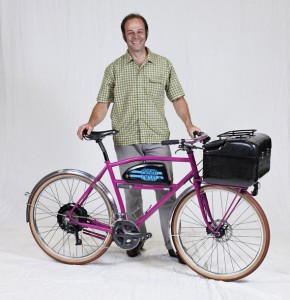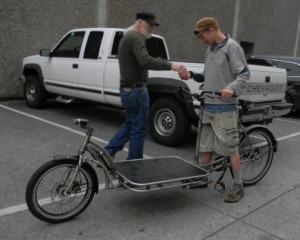
I am back in the U.S. after another busy product development trip in China. I worked long days on this trip, and the 12-hour time difference always hits me harder when I return home, so I am not up for writing much of a post this afternoon. My brain is fried, but I want to quickly mention the Oregon Manifest Constructor’s Design Challenge results before the week is out. Tony Pereira, who also won the first Manifest in 2009, took the top prize last Saturday with a custom electric assist bike which features a big black box on the front rack. The box is lockable, includes USB ports for charging devices on the go, and houses an integrated sound system. From the little bit I have read so far, those all seemed to be details that the judges liked, giving this bike the edge over the others in the competition. Honestly, I don’t know much more about it than that, so I will reserve my comments until I read more about all the entries.
You can find out more about the winners, and runners up, at the Core77 blog and at this Bike Portland post which features quite a few pictures from the event. Also, check out the three bikes (really 2 bikes and a trike) that resulted from the collaborations between design firms and framebuilders…and be sure to vote for your favorite Creative Collaboration on the Oregon Manifest website.
 One bike that I am curious about is the cargo bike built by Vimana Cycle (pictured here…I think). A reader, Deb, left the following comment about that bike in response to an older post about the completion:
One bike that I am curious about is the cargo bike built by Vimana Cycle (pictured here…I think). A reader, Deb, left the following comment about that bike in response to an older post about the completion:
“I was at the Manifest on Saturday and was wondering about the rider who rolled across the finish line first, number 27. The officials put the bike and rider off to the side and not a word was said about them. It was a very interesting looking cargo bike and I heard several people in the crowd asking what was going on. I stopped and chatted with the rider for few minutes and he said the bike was built by Vimana but had been disqualified from the competition because it had not been finished in time for the judging. It just seemed kind of odd like the officials didn’t know what to do with a bike and rider that had clearly made the 50 mile test and rolled in far ahead of the rest of the field. The bike was obviously a well built and capable cargo hauler. And apparently fast. The crowd seemed surprised that a cargo bike finished first. Anyone have a clue what that was about?”
As she said, it was disqualified after the 51-mile field test and was not eligible for the judges to vote on, but I would love to hear more about the cargo bike that placed first in the race. If you know anything about it, fill me in with a comment.

Leave a Reply